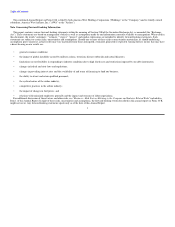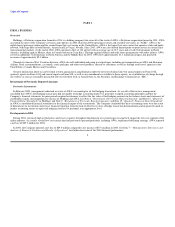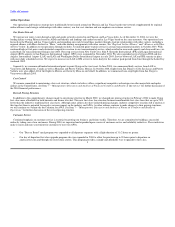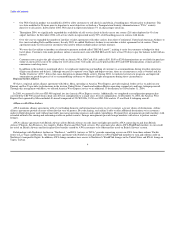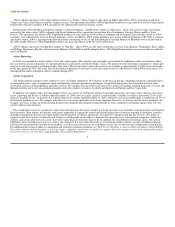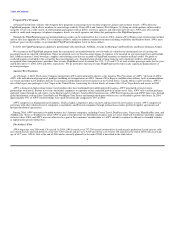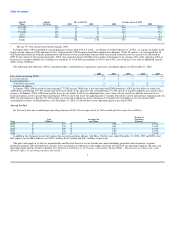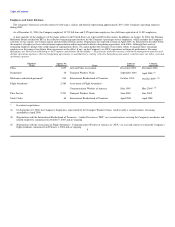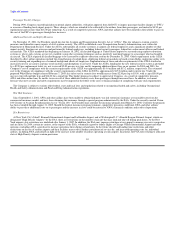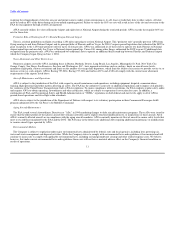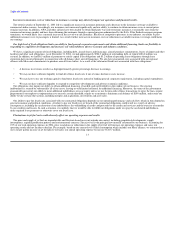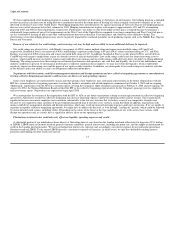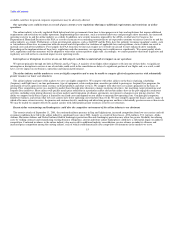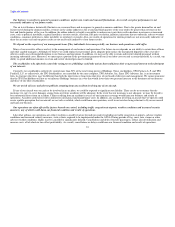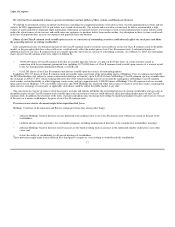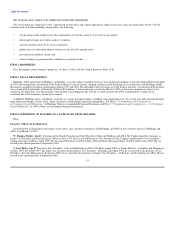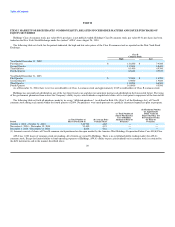US Airways 2004 Annual Report Download - page 14
Download and view the complete annual report
Please find page 14 of the 2004 US Airways annual report below. You can navigate through the pages in the report by either clicking on the pages listed below, or by using the keyword search tool below to find specific information within the annual report.
Table of Contents
requiring the relinquishment of slots for non-use and permit carriers, under certain circumstances, to sell, lease or trade their slots to other carriers. All slots
must be used on 80% of the dates during each two-month reporting period. Failure to satisfy the 80% use rate will result in loss of the slot and reversion to the
FAA for reassignment through a lottery arrangement.
AWA currently utilizes five slots at Kennedy Airport and eight slots at National Airport during the restricted periods. AWA exceeds the requisite 80% use
rate for these slots.
Perimeter Rule at Washington D.C.'s Ronald Reagan National Airport
There is a federal prohibition on flights exceeding 1,250 miles operating to or from National Airport. This "perimeter rule" generally prevents AWA from
flying nonstop to and from National Airport and its principal hubs of Phoenix and Las Vegas. In 2000, Congress passed legislation that authorized the DOT to
grant exceptions to the 1,250-mile perimeter rule for up to 12 slots per day. AWA was authorized six of these slots to operate two daily Phoenix to National
Airport round trips and one daily Las Vegas to National Airport round trip. Vision 100, among other things, authorized the DOT to grant 12 additional slots
exempted from the perimeter rule. AWA was authorized two additional slots to operate an additional daily round trip between Phoenix and National Airport
which the Company began flying on June 1, 2004.
Noise Abatement and Other Restrictions
Numerous airports served by AWA, including those in Boston, Burbank, Denver, Long Beach, Los Angeles, Minneapolis-St. Paul, New York City,
Orange County, San Diego, San Francisco, San Jose and Washington, D.C., have imposed restrictions such as curfews, limits on aircraft noise levels,
mandatory flight paths, runway restrictions and limits on the number of average daily departures, which limit the ability of air carriers to provide service to, or
increase service at, such airports. AWA's Boeing 757-200s, Boeing 737-300s and Airbus A319s and A320s all comply with the current noise abatement
requirements of the airports listed above.
Aircraft Maintenance and Operations
AWA is subject to the jurisdiction of the FAA with respect to aircraft maintenance and operations, including equipment, dispatch, communications,
training, flight personnel and other matters affecting air safety. The FAA has the authority to issue new or additional regulations and to impose civil penalties
for violations of the United States Transportation Code or FAA regulations. To ensure compliance with its regulations, the FAA conducts regular safety audits
and requires AWA to obtain operating, airworthiness and other certificates, which are subject to suspension or revocation for cause. In addition, a
combination of FAA and Occupational Safety and Health Administration or "OSHA," regulations on both federal and state levels apply to all of AWA's
ground-based operations and to in-flight cabin attendants.
AWA also is subject to the jurisdiction of the Department of Defense with respect to its voluntary participation in their Commercial Passenger Airlift
program administered by the Air Force's Air Mobility Command.
Aging Aircraft Maintenance
The FAA issued several Airworthiness Directives or "ADs," in 1990 mandating changes to older aircraft maintenance programs. These ADs were issued to
ensure that the oldest portion of the nation's aircraft fleet remains airworthy and to require structural modifications to, or inspections of, those aircraft. All of
AWA's currently affected aircraft are in compliance with the aging aircraft mandates. AWA constantly monitors its fleet of aircraft to ensure safety levels that
meet or exceed those mandated by the FAA and the DOT. The FAA may in the future issue additional ADs requiring additional maintenance or modifications
to various aircraft types operated by AWA.
Environmental Matters
The Company is subject to regulation under major environmental laws administered by federal, state and local agencies, including laws governing air,
water and waste management and disposal activities. While the Company strives to comply with environmental laws and regulations, it has incurred and will
continue to incur costs to comply with applicable environmental laws, including soil and groundwater cleanup and other related response costs. We believe,
however, that under current environmental laws and regulations these costs will not have a material adverse effect on the Company's financial condition or
results of operations.
11


